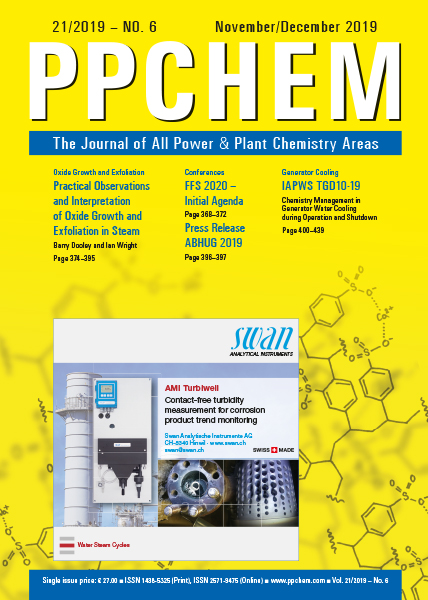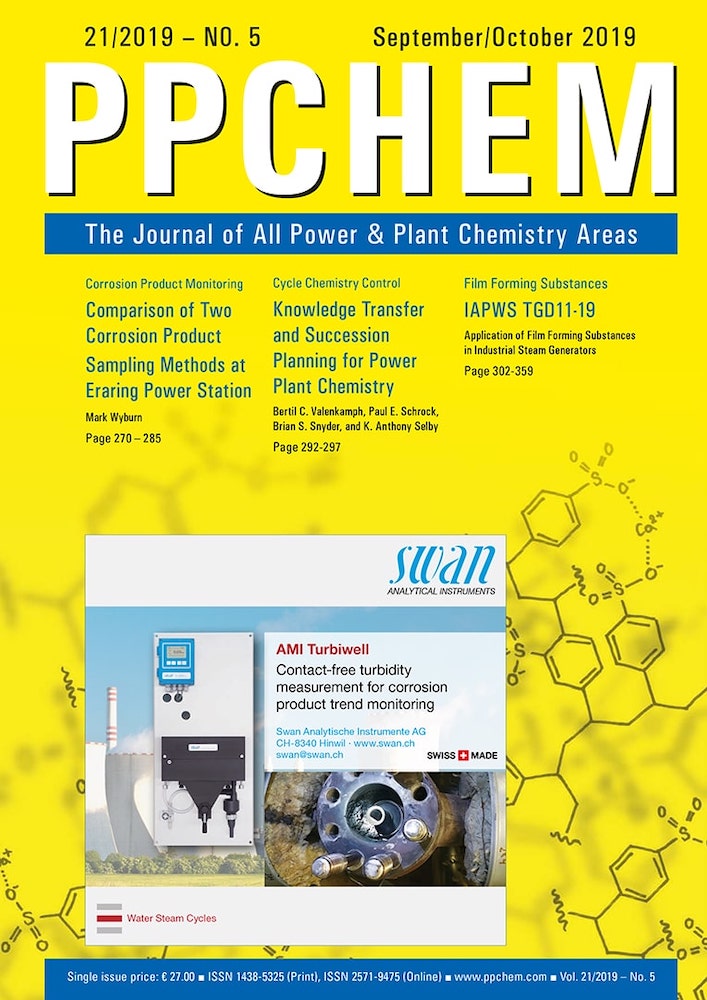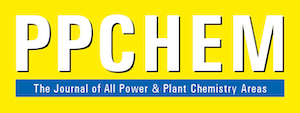Author: anderthalbAdmin
Article – Issue 01 (2020) – Water Chemistry Management for the Primary Circuit of the First EPR Unit during Hot Functional Testing
E-Paper – Issue 01 (2020)
Article – Issue 01 (2020) – 2019’s Scientific and Technical Contributions
E-Paper – Issue 06 (2019)
Issue 06 (2019)

For members only
ABSTRACTS
Practical Observations and Interpretation of Oxide Growth and Exfoliation in Steam
Barry Dooley and Ian Wright
Over the last 40 years oxide growth and exfoliation (OGE) in superheater and reheater tubing have been responsible for a number of power plant problems which seriously have affected reliability. In the same time period, the authors have collected a data base of scale morphologies that has been used to describe in detail the progression of oxide scale development to the point where failure can occur. The concomitant evolution of knowledge of the factors that determine the mode of scale growth and failure in steam has provided the foundation for defining the specific stages in that progression, understanding differences among ferritic and austenitic alloys, and for categorizing the influence of plant operating characteristics. In particular, while tube/steam temperature and the maximum temperature drop at plant shutdown are major variables, the specific cycle chemistry used for the plant feedwater has very little influence. Key stages in the progression of scale growth to the point of failure are identified as OGE indices that are specific for ferritic and austenitic steels. These indices are intended to be used proactively to determine the current condition of a superheater or reheater on the path to exfoliation and possible plant damage. Also, by analyzing samples of exfoliant or oxide deposits responsible for damage, the origin of the oxide, and thus a possible superheater or reheater problem, can be identified retroactively.
PPCHEM® 2019, 21(6), 374–395
For Members only
ABHUG 2019 Highlights and Press Release
The first annual meeting of ABHUG held on the 30th October to 1st November 2019 in Brisbane, Australia was chaired by Barry Dooley of Structural Integrity Associates. This first ABHUG conference followed 11 annual meetings of AHUG (Australasian HRSG Users Group) and included conventional fossil plant technology and issues closely related to those in HRSGs. ABHUG 2019 attracted 75 participants from Australia, Japan, New Zealand, Thailand, UK, and USA. About 50% of the participants were Users, which is the highest of the other HRSG forums worldwide.
PPCHEM® 2019, 21(6), 396–397
IAPWS TGD10-19 Chemistry Management in Generator Water Cooling during Operation and Shutdown
The International Association for the Properties of Water and Steam
This Technical Guidance Document applies to all generators with water-cooled windings. From the operating side, adherence to a suitable water chemistry regimen as well as proper layup practices help to avoid or mitigate flow restrictions. Other influencing factors are design and materials. It is emphasized that this is an IAPWS Technical Guidance Document and that, depending on local requirements, the normal or target values will need to be customized for each case, depending on the actual conditions of operation and maintenance.
PPCHEM® 2019, 21(6), 400–439
Article – Issue 06 (2019) – IAPWS TGD10-19 Chemistry Management in Generator Water Cooling during Operation and Shutdown
Article – Issue 06 (2019) – ABHUG 2019 Highlights and Press Release
Article – Issue 06 (2019) – Practical Observations and Interpretation of Oxide Growth and Exfoliation in Steam
Issue 05 (2019)

For members only
ABSTRACTS
Comparison of Two Corrosion Product Sampling Methods at Eraring Power Station
Mark Wyburn
Cycle chemical conditions have been modified several times over the last 20 plus years at Eraring Power Station (EPS) in Australia. The mixed metallurgy of the condensate system had proved difficult to manage with respect to minimising flow-accelerated corrosion (FAC) and copper transportation.
A project to convert all units from all-volatile treatment under reducing conditions (AVT(R)) to all-volatile treatment under oxidising conditions (AVT(O)) has been underway since 2016. Units 1, 2 and 4 have now had their 35-year-old brass-tubed low-pressure (LP) heaters replaced with stainless-steel-tubed heat exchangers, and Unit 3 will be converted in late 2019.
After each AVT(O) conversion, intensive corrosion product sampling and analysis has been undertaken over several months to measure the success of the project in reducing iron transportation. This has involved simultaneously using integrated sampling and an on-line voltammetric analyser, which was previously trialled in 2015. This analysis has revealed some interesting trends during the chemistry change.
This paper compares the results from integrated sampling and the voltammetric analyser and discusses the relative merits of each process under the constraints of major power plant operations in a competitive market.
PPCHEM® 2019, 21(5), 270–285
For Members only
Knowledge Transfer and Succession Planning for Power Plant Chemistry
Bertil C. Valenkamph, Paul E. Schrock, Brian S. Snyder, and K. Anthony Selby
Electric utilities are faced with a shortage of skilled personnel in the coming years due to normal retirements, early retirements, and plant closings. This is true in chemistry departments as well as other departments.
There are many aspects to succession planning to successfully fill the upcoming vacancies. For chemistry departments one important tool is to develop comprehensive written plans for chemical control of the systems impacted by chemistry. These plans can be termed control plans or strategic plans. The chemistry plans should be developed for several individual plant systems, including boiler cycle chemistry, open cooling water, closed cooling water, makeup treatment systems, glycol systems, and wastewater treatment systems, among others.
Another very important tool is the comprehensive chemistry data acquisition system – a collection of supervisory control and data acquisition (SCADA) nodes at each generating station, accompanied by a combined web-based management system overview. These systems are vital in monitoring all the process chemistry systems explained in the aforementioned control/strategic plans.
This paper describes the development and content of control/strategic plans for chemistry control in these various systems as well as several other succession planning items.
PPCHEM® 2019, 21(5), 292–297
For Members only
IAPWS TGD11-19: Application of Film Forming Substances in Industrial Steam Generators
The International Association for the Properties of Water and Steam
This Technical Guidance Document addresses the use of film forming substances in the water/steam cycles of industrial steam generating plants.
In order to control corrosion throughout the water/steam circuits of industrial steam generating plants, it is essential for the operator of the plant to choose and optimize a chemical treatment scheme that is customized to that plant. IAPWS has provided guidance on the use of volatile treatments as well as for phosphate and caustic treatments; this document addresses the use and application for the range of chemicals referred to as film forming substances (FFS). As well as providing background information on FFS, the document includes guidance in Section 8 for determining if a FFS should be applied, the tests required before application, the locations for the addition, the optimum dosage level, and tests to determine the benefits of applying FFS. It is emphasized that this is an IAPWS guidance document and that, depending on local plant requirements, the application of FFS will need to be customized (Section 9) for each industrial plant depending on the actual conditions of operation, the equipment and materials installed, the condenser cooling media, and applicable regulations.
PPCHEM® 2019, 21(5), 302–359

